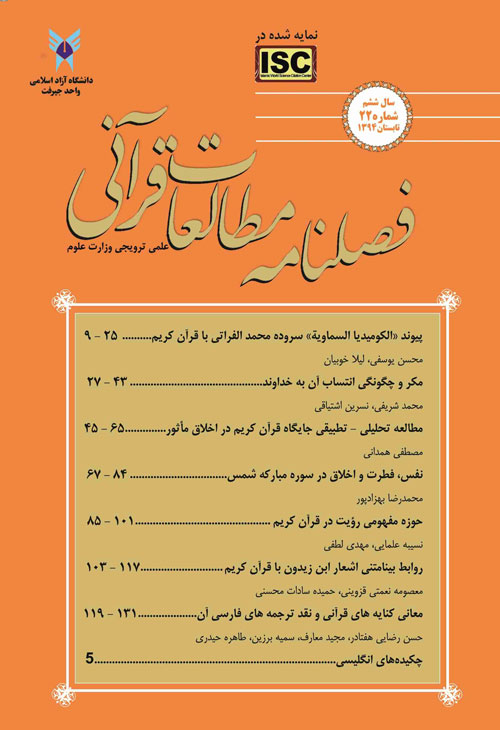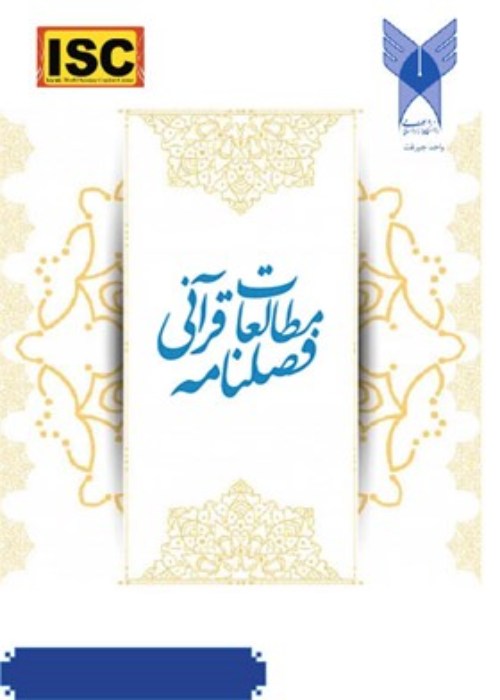فهرست مطالب

نشریه مطالعات قرآنی
پیاپی 22 (تابستان 1394)
- تاریخ انتشار: 1394/05/30
- تعداد عناوین: 7
-
-
صفحات 9-25قرآن کریم به عنوان والاترین شاهکار نثر فنی و معجزه خاتم انبیاء، غنی ترین متنی است که سروده های بسیاری از شاعران با آن پیوند برقرار نموده است؛ از جمله این شاعران محمد الفراتی، شاعر و مترجم نامدار معاصر عربی است که تعابیر و مفاهیم قرآنی را به گونه ای هنرمندانه و با خلاقیتی خاص، توام با ظرافت های ادبی در شعرش به کار رفته است و باعث جذابیت و تاثیرگذاری فوق العاده اشعارش شده است. بدین منظور پژوهش حاضر در پی آن است که با روش تحلیلی – توصیفی به تبیین و تشریح بینامتنی قرآنی در سروده «الکومیدیا السماویه» بپردازد تا از این رهگذر به شناخت چگونگی و میزان تاثیرگذاری قرآن بر روساخت و ژرف ساخت اشعار او دست یابد.کلیدواژگان: قرآن کریم، محمد الفراتی، الکومیدیا السماویه، بینامتنی
-
صفحات 27-43در آیاتی از قرآن کریم به ویژه پس از نسبت دادن مکر به غیر خدا این صفت به خدا نیز نسبت داده شده است و این شبهه را در ذهن ایجاد می کند که آیا خداوند هم مانند انسان ها مکر می کند و چرا خداوند خود را با صفت خیر الماکرین وصف نموده است؟ نگارندگان در این پژوهش بر آن اند تا با روش توصیفی – تحلیلی و با استناد به آیات قرآن و دیدگاه مفسران، تفاوت مکر انسان و مکر الهی و ویژگی های مکر الهی را واکاوی نمایند.کلیدواژگان: مکر، مکر الهی، کید، خدعه
-
صفحات 45-65این نوشتار به تحلیل محتوای تطبیقی کتاب های «جامع السعادات» تالیف علامه نراقی، «سر الاسراء فی شرح حدیث المعراج» تالیف مرحوم آیت الله سعادت پرور و کتاب «اخلاق در قرآن» تالیف آیت الله مصباح یزدی از نظر میزان استفاده هر یک از این سه کتاب از آیات قرآن کریم در تحلیل های اخلاقی اختصاص دارد تا ضمن معرفی عملی کارکردهای تحلیل محتوا در تحقیقات حوزه علوم قرآن و تفسیر، به ارزیابی نقش قرآن کریم در استنباط آموزه های اخلاقی ماثور بپردازد. روش تحقیق در این نوشتار، تلفیقی از تحلیل محتوا و روش کتابخانه ای است. نوع تحقیق، توصیفی - تحلیلی است که در تجزیه و تحلیل از روش های سه گانه کمی، کیفی و تطبیقی استفاده می کند.کلیدواژگان: اخلاق ماثور، استنباط اخلاقی از قرآن، فحص قرآنی
-
صفحات 67-84در این مقاله تلاش می شود که بنیان های معرفتی و فطری اخلاق با تکیه بر آیات قرآن، به ویژه سوره مبارکه شمس روشن شود. برای فهم فطرت و اخلاق لازم است نفس را به عنوان موجودیتی باقی و ابدی بشناسیم. این پژوهش با هدف شناخت بنیان های اخلاق بر اساس فطرت شناسی و نفس شناسی طرح شده در سوره مبارکه شمس انجام شده است. سوره مبارکه شمس تزکیه نفس را به عنوان مهم ترین رسالت بشر معرفی و با توجه به فطرت انسان اخلاق را تنها راه تزکیه نفس معرفی می فرماید. بررسی نظریات مربوط به نفس و فطرت از سوی فلاسفه و در نهایت آنچه در آیات متعدد قرآن کریم و سوره مبارکه شمس آمده است و لزوم اخلاقی بودن افعال انسان در این مقاله مورد توجه قرار گرفته است.کلیدواژگان: نفس، فطرت، اخلاق، سوره شمس
-
صفحات 85-101نگاه خداوند نسبت به مخلوقات خود خصوصا انسان و نگاه انسان به جنبه های مختلف و پیرامون خود، مفاهیم و تفاصیل گوناگونی دارد و علاوه بر آن نگاه بر کیفیت شناخت و احساسات تاثیر دوطرفه دارد. به عبارت دیگر نگاه هر شخصی بر نوع شکل گیری احساسات، عواطف و شناخت بشری نسبت به خود و محیط پیرامون اش اثر می گذارد و بر عکس این تاثیر دوسویه و دوطرفه است. مقاله حاضر ضمن بررسی واژه شناختی رویت در قرآن به تقسیم بندی های مختلف آن می پردازد و زوایای مختلف این مفهوم را در قرآن مورد تحقیق قرار می دهد.کلیدواژگان: قرآن، رویت، نظر، رویت خدا، بصیرت
-
صفحات 103-117به طور کلی هر انسانی در فرایند عقلانی، فکری و حتی عاطفی خود از افکار، ایده ها و مکاتب مختلف تاثیر می پذیرد. «بینامتنی» نظریه ای است که با ورودش به حوزه نقد ادبی، باعث ایجاد تحولی شگرف در این زمینه گشت. بر اساس این نظریه، هر متنی، آگاه یا ناخودآگاه، زایش و بازخوانشی از دیگر متون پیش از خود یا معاصر با خود است. بنا بر این نظریه، بسیاری از متون عربی را می بینیم که هر کدام در انواع و اشکال مختلف، با متون کلاسیک گران سنگ عربی، دارای روابط بینامتنی است که البته سهم قرآن در این میان، از دیگر متون بیش تر بوده است. ابن زیدون یکی از شاعران برجسته اندلس است که در اشعار خود از قرآن کریم اثر پذیرفته است. بر این اساس پژوهش حاضر با روش تحلیلی- توصیفی به تبیین گونه های مختلف بینامتنی قرآنی در اشعار این شاعر پرداخته و به این نتیجه رسیده است که ابن زیدون با سه شیوه تلمیحی، گزاره ای و واژگانی از قرآن کریم تاثیر پذیرفته است که البته سهم شیوه سوم بیش تر از دو شیوه دیگر است.کلیدواژگان: قرآن کریم، بینامتنی، شعر اندلس، ابن زیدون
-
صفحات 119-131نتایج پژوهش حاضر، گواه آن است که ترجمه کنایی، بهترین ترجمه برای تعابیر کنایی است. در غیر این صورت، باید به ترجمه معنایی روی آورد و تا حد امکان، از ترجمه تحت اللفظی اجتناب کرد. و در این زمینه تسلط و اشراف مترجم بر بلاغت به عنوان یکی از علوم پیش نیاز ترجمه و آشنایی وی با فرهنگ زبان های مبدا و مقصد امری ضروری است. ضمنا از رهگذر این جستار، مشخص می شود که اموری مانند تاکید بر عظمت و قدرت خداوند، بیان زیرکی و هشیاری مخاطب، زیباکردن لفظ، رعایت ادب و اجتناب از الفاظ زشت، مبالغه و اختصار، از مهم ترین اسرار بلاغی تعابیر کنایی قرآن بوده که توجه به آن ها، مترجم را در فهم بهتر معانی کنایه های قرآنی یاری می رساند.کلیدواژگان: کنایه، اسرار بلاغی، ترجمه های معاصر قرآن
-
Pages 9-25Holy Quran as the superior masterpiece and Prophet Muhammads miracle is the most complete text that many poets verses and poetries make conjunctions with it. One of these poets is Mohammad Al Forati well known Arab poet and translator who joined Quranic interpretations and concepts with his verses in artistic and creative way which made his works attractive and effective. Thus the present article tries to express and explain the Quranic intertextuals in analytical descriptive method in order to discover the Qurans effect on surface structure and deep structure of Foratis poetries.Keywords: Holy Quran, Mohammad Al Forati, Al Comidia Al Samawiyah, intertextuality
-
Pages 27-43In some of the verses of Holy Quran the trick adjective is attributed to Allah and creates the doubt of Gods tricking; and raises this question in humans mind that God tricks as human does and why Allah describes himself as the Best Planner. The authors of the present study attempt to survey the interpreters point of view and the differences between human tricks and Allahs in descriptive analytical method.Keywords: trick, divine trick, plan, wile
-
Pages 45-65The present article surveys the comparative study of Jami' al-Saadat (Collector of Felicities) by Allameh Naraqi, Ser Al Asrar fi Sharh-e Hadith Al Meraj by Saadat Parvar and Ethics in Quran by Mesbah Yazdi from the Quranic ethical analysis point of view in order to introduce the applications of content analysis in the field of Quranic science research as well as assessment of Qurans role in ethics understanding. The research method of the present study is descriptive analytical.Keywords: Affected behavior, ethical understanding of Quran, Quranic eloquence
-
Pages 67-84The present article tries to clarify the knowledge and natural fundamentals of ethics by emphasizing the Quran verses especially in Shams Surah. In order to understand the nature it is necessary to know the ego as an eternal and everlasting existence. The present article has been done based on egoism and ethics brought in Shams Surah. The mentioned surah introduces self-purism as the most important goals of human being and says that the nature of human ethics is to purify him.Keywords: Ego, Nature, Ethics, Shams surah
-
Pages 85-101Gods vision to His creations especially to human being and humans vision to different aspects and around is of different concepts and interpretations and moreover vision has a bilateral effect on knowledge and emotions. In other words each individuals sight and vision effects the emotions formation, feeling and human knowledge of himself and all around him and this effect is bilateral. The present article studies the lexicology of vision and sight in Quran as well as its classifications and different aspects of this concept in Quran.Keywords: Quran, vision, sight, God's vision, insight
-
Pages 103-117In general every human being is affected by thoughts, ideas and schools in his thinking process. Intertextuality is a theory which has made remarkable change in this field by its influence in literature criticism. According to this theory, any text conscious or unconscious is a reading or recreation of another text parallel or before it. There are many Arabic texts which have intertextual relations with Arabic classic texts. Ibn Zeydun is one of the Andalusia poets whose poetries are affected by Holy Quran. The present article studies different types of intertextuality in analytical descriptive method.Keywords: Holy Quran, intertextuality, Andalusia poetry, Ibn Zeydun
-
Pages 119-131The results of the present research prove that the metaphoric translation is the best translation for metaphoric interpretations. Otherwise the literal translation should be done and the word to word translation should be avoided. The fluency and dominance of the translator is an inevitable factor. By the present research it would be clarified that emphasizing Allahs Greatness, the audience awareness, words beautification, politeness and avoiding impolite words are of the most important rhetoric secrets of Quran.Keywords: metaphor, rhetoric secrets, contemporary translations of Quran


